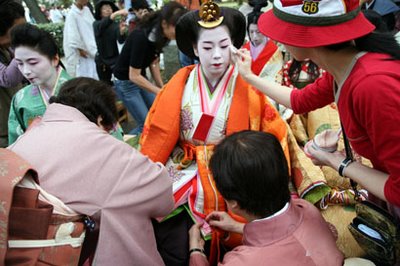
A Heian period princess, dressed in the 12 layered kimono popular with the imperial court in that era, patiently waits as the final touches are applied to her make up and kimono before participating in Kyoto's Jidai Matsuri: The Festival of Ages.

During the Heian period (794-1192), the subtle matching of different colored robes was considered a great skill, an expression of artistic sensibility that revealed the character of the wearer. In a woman, this skill was more highly valued than her ethical or moral character, and even held more sway than the physical features she was born with. The Heian society was “on the whole governed by style rather than by moral principles”.
 Colors and patterns of the "juni-hitoe" (12 layers- a rather arbitrary number, as some women wore as many as 20) reflected many things, including: rank, seasons, directions, virtues, and elements of the earth as they related to spirits of nature. The multiple layers also helped in staying warm in winter. Eventually, sumptuary laws of the Edo Period standardized the number of layers to five.
Colors and patterns of the "juni-hitoe" (12 layers- a rather arbitrary number, as some women wore as many as 20) reflected many things, including: rank, seasons, directions, virtues, and elements of the earth as they related to spirits of nature. The multiple layers also helped in staying warm in winter. Eventually, sumptuary laws of the Edo Period standardized the number of layers to five.
Fans carried by ladies of the Heain Imperial court.

Over 2,000 Kyoto residents take part in the great procession of the Festival. Many maiko and geisha also make an appearance, dressed as some of the most famous women of Japanese history.

The costumes used in the festival are authentic, created according to the techniques used during the period, and are valued at over $25 million.

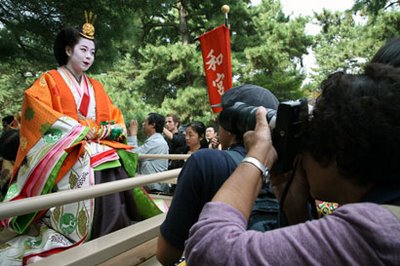
Wednesday, October 25, 2006
Kyoto Nights
Mamehide rushing through Shirakawa (Gion) on her way to an engagement. Both her Kimono ensemble and her kanzashi, particular to October, celebrate the beauty of fall in Japan. Her kimono and collar are decorated with momiji, Japanese maple leaves, and kiku, chrysanthemums, the symbol of the Imperial family and a much beloved flower in Japan. The small green ornament is the famous tsunagi dango, the linked dumpling crest of Gion, which symbolizes the solidarity between the different geiko districts. Her upper lip is not painted, alluding to her rank as a first year maiko. Her collar is heavily embroidered in red, which also points to her low rank. As maiko advance in the ranks, their collars become predominantly whiter until they are ready to become a full fledged Geiko.
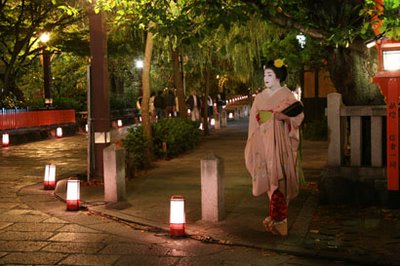
A quite night in Gion. Katsue, a young, high ranking maiko from Kamishichiken, standing near the small shrine enjoying lantern lit Shirakawa.
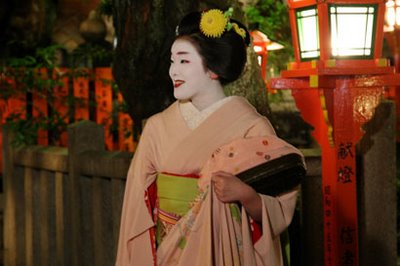 Katsue greeting a friend with a smile. Note her white collar, crimson lips, and kanzashi (hair ornament). As a higher ranking maiko, she no longer wears the long, dangling bira bira kanzashi that Mameteru is wearing above. Instead she wears a simple chrysanthemum blossom.
Katsue greeting a friend with a smile. Note her white collar, crimson lips, and kanzashi (hair ornament). As a higher ranking maiko, she no longer wears the long, dangling bira bira kanzashi that Mameteru is wearing above. Instead she wears a simple chrysanthemum blossom.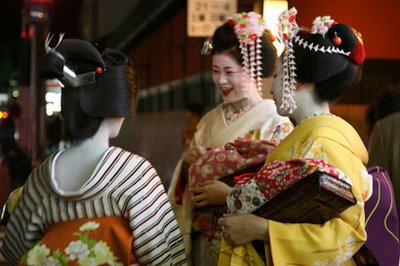 Two young maiko laugh with their big sister on the corner of the Hanamikouji and Shijo, Gion.
Two young maiko laugh with their big sister on the corner of the Hanamikouji and Shijo, Gion.
Friday, October 20, 2006
Kyoto: Where My Heart Belongs
 Almost Famous: Kotoha, A young, high rank maiko named Kotoha makes her to the big party at the Ichiriki teahouse after the main procession of Yamahoko Junko last July.
Almost Famous: Kotoha, A young, high rank maiko named Kotoha makes her to the big party at the Ichiriki teahouse after the main procession of Yamahoko Junko last July. I'm headed to Kyoto for Jidai Matsuri: The Festival of Ages. I haven't been to Kyoto since July(way too long) but here are some of the photos I took during the summer and never got around to sharing. Enjoy!
 A young, first year maiko on her way to an appointment during Gion Matsuri. Geiko still use traditional, oiled paper umbrella in the rain and snow. This was my first time actually seeing a maiko or geiko use one. Breath-taking. This is also the first image taken with my new camera (^-^)/ I'm still learning how to use it. Non-stop pouring rain + fast moving maiko = a great learning experience! The blur helps conveys the hustle and bustle of the crowded street, the young maiko rushing through the crowd to her appointment, and the dreary, dripping rain. It looks ethereal, like a scene from a dream, which is exactly the way I felt when I shot it.
A young, first year maiko on her way to an appointment during Gion Matsuri. Geiko still use traditional, oiled paper umbrella in the rain and snow. This was my first time actually seeing a maiko or geiko use one. Breath-taking. This is also the first image taken with my new camera (^-^)/ I'm still learning how to use it. Non-stop pouring rain + fast moving maiko = a great learning experience! The blur helps conveys the hustle and bustle of the crowded street, the young maiko rushing through the crowd to her appointment, and the dreary, dripping rain. It looks ethereal, like a scene from a dream, which is exactly the way I felt when I shot it.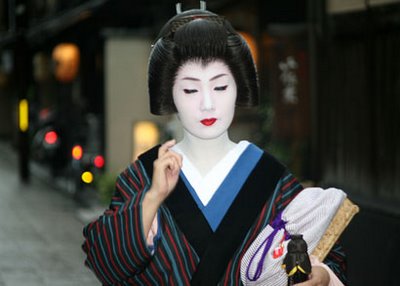 Eyes Wide Closed: Gion. A geiko making her daily communte through the streets of Gion. Geiko wear wigs called katsura, with almost no ornamentation (compared to maiko, who style their own hair, which is adorned with many kanzashi, or flowered ornaments). Of course she blinked the exact moment I pressed the shutter, but what a perfect face.
Eyes Wide Closed: Gion. A geiko making her daily communte through the streets of Gion. Geiko wear wigs called katsura, with almost no ornamentation (compared to maiko, who style their own hair, which is adorned with many kanzashi, or flowered ornaments). Of course she blinked the exact moment I pressed the shutter, but what a perfect face. A young geiko waiting outside the Ichiriki Teahouse in Gion with her client. Customers pay about $200 dollars an hour for the privledge of spending time with geiko (kyoto dialect for geisha), but having money is not the only requirement. Customers must have a relationship with an ochaya, a place where geiko entertain, in order to make an appointment, and being introduced to an ochaya is no simple task. The refined manners of Kyoto dictate that charging a customer at the end of the night is a no-no. With bills often running past 5,000$ a night, Ochaya must have a relationship based on trust, so that they can rest assured that the bills that they send to their customers once a month will be paid.
A young geiko waiting outside the Ichiriki Teahouse in Gion with her client. Customers pay about $200 dollars an hour for the privledge of spending time with geiko (kyoto dialect for geisha), but having money is not the only requirement. Customers must have a relationship with an ochaya, a place where geiko entertain, in order to make an appointment, and being introduced to an ochaya is no simple task. The refined manners of Kyoto dictate that charging a customer at the end of the night is a no-no. With bills often running past 5,000$ a night, Ochaya must have a relationship based on trust, so that they can rest assured that the bills that they send to their customers once a month will be paid.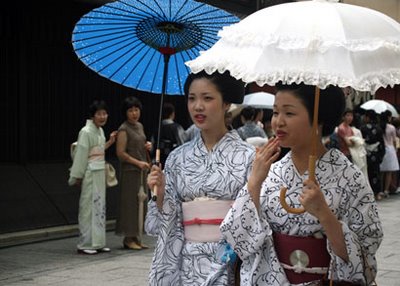 Two maiko make their way through the busy streets of Gion, sheltered from the sweltering summer sun by their umbrellas. Daytime casual: No white makeup, no heavy silk kimono. Just cotton yukata and lip gloss (^-^). I've never seen a maiko with a western umbrella before (right). Interesting. Also love the way the two older women watched them pass with awe, reverence and pride.
Two maiko make their way through the busy streets of Gion, sheltered from the sweltering summer sun by their umbrellas. Daytime casual: No white makeup, no heavy silk kimono. Just cotton yukata and lip gloss (^-^). I've never seen a maiko with a western umbrella before (right). Interesting. Also love the way the two older women watched them pass with awe, reverence and pride.It is a Japanese custom for women to cover their mouths when smiling,laughing, and even sometimes, speaking. This young maiko was laughing as she talked with her friend, which is as she talked with her friend, which is why her hand is raised just so.
 An older "sister", an accomplished and high ranking geiko, accompanying a few younger maiko, or apprentice geisha, to a tea ceremony held at the famous Ichiriki Teahouse. The way the older women on the right hold themselves, and the sensual way they touch themselves, even in such a casual way....
An older "sister", an accomplished and high ranking geiko, accompanying a few younger maiko, or apprentice geisha, to a tea ceremony held at the famous Ichiriki Teahouse. The way the older women on the right hold themselves, and the sensual way they touch themselves, even in such a casual way.... I love you, too, Beautiful Mountain School!
I love you, too, Beautiful Mountain School!
No comments:
Post a Comment